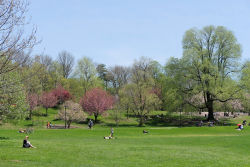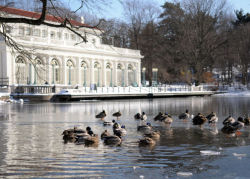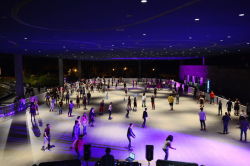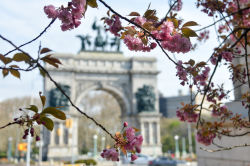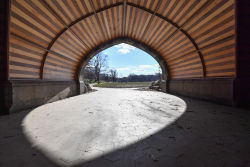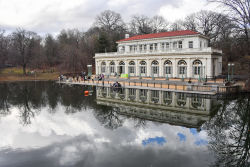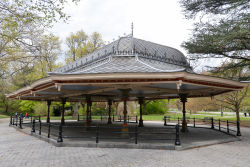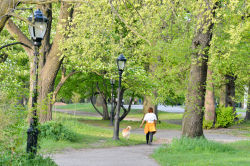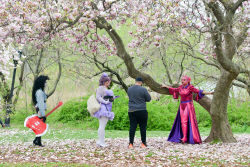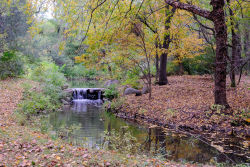Prospect Park
The Daily Plant : Thursday, October 14, 2010
From Parks' Citywide Nursery: Andrew Jackson Downing And The Cucumber Magnolia
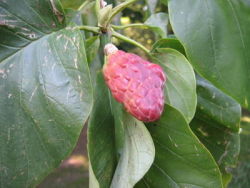
The City Birder
Richie Cabo is horticulturist and manager at Parks’ Arthur Ross Citywide Nursery, where he oversees the propagation of thousands of plants using all organic, eco-friendly processes. For the past year, a special tree discovery inspired Richie to research the New York horticulturist Andrew Jackson Downing. This essay is about his findings and his journey.
On a fall day last September, I was driving with my family on our way to climb Mount Beacon in Dutchess County. We passed the Craig House, a large property with an old mansion, and I pulled over to get a closer look at a beautiful tree. It had large leaves and white flowers, and unusual orange, cucumber-shaped fruits. I also noticed the largest Weeping Hemlock I’d ever seen. The property’s majestic, unusual landscaping stayed with me not only on our hike, but to this day.
At the nursery, we stratified the strange fruit seeds that I’d collected throughout the winter and they sprouted in the spring. We transplanted them and they have grown beautifully—they are now two years old. As the trees grew, I noticed that they looked like a Magnolia, but the flower was different. I asked among the gardeners and heard that Fort Tryon had a Cucumber Magnolia that, sure enough, was a match.
I learned that the Magnolia acuminata (Cucumber Magnolia), now listed as endangered in the U.S. and Canada, was the favorite tree of Andrew Jackson Downing—a name I had only heard briefly mentioned during a master gardener’s class. I started to research Downing and learned that he is considered one of the most influential characters in the American history of horticulture.
The trees continued to grow, and about a year after planting, I read in the Poughkeepsie Journal that plantings and grounds at the Craig House estate in Beacon had been “overseen by a renowned horticulturist, Henry Winthrop Sargent.”
It was as if a light bulb went off in my head: I remembered that there was a tree named Weeping Hemlock Sargentii. The fact that the two horticulturist names were associated with one landscape—Craig House, home to the same magnificent landscape that had the Cucumber Magnolia—made me want to look more closely at the connection between Sargent and Downing. I have been a student of horticulture for some time, and yet I had no idea who these two horticulturists were. But a tree was calling for me to find out more, to dig deeper. This journey through history all started with the propagation of a tree seed.
I learned that Downing had been close friends with Sargent, who lived across the river from him in Beacon. Sargent introduced Downing to the Craig House property that would eventually be home to the beautiful Cucumber Magnolia, and the two worked on the grounds design together. Downing also worked closely with Central Park designer Calvert Vaux. Together, their designs for cottage homes, Villas, and farmhouses and shaped the style of early American homes.
The librarians at the Newburgh Historical Society provided me with Downing’s book, A Treatise on the Theory and Practice of Landscape Gardening, and I learned that Downing had learned the horticulture trade at his father’s nursery in Newburgh, NY—across the river from the Craig House. Downing’s father had over 100 types of apple and pear trees at his cutting-edge nursery.
Until his death, Downing was the founding editor of the first monthly periodical about horticulture in America, the Horticulturist. I was astonished to find that it is in this periodical that the concept of New York’s Central Park is first introduced. In August of 1851, eight years before what we now know as Central Park was born, Downing wrote a piece entitled “The New York Park.” “Plant spacious parks in your cities,” Downing wrote, “and unloose their gates of morning to the whole people.”
I was confused, though: if Downing was the first to write about a New York Central Park, why have I only heard about its designers, Frederick Law Olmsted and Calvert Vaux? I learned at Newburgh’s Historical Society that Downing died in a tragic boating accident on the Hudson River in 1852—in other words, before Central Park opened. He was just 36 years old.
I owe a great deal to Andrew Jackson Downing, and in studying his life, I’m reminded by how history can inform our everyday lives and how easily it can be lost. How can Downing be remembered for new generations of horticulturists? Calvert Vaux designed an urn his memory that is now at the Smithsonian Institute, and there is a park in his name in Newburgh, but beyond a few books buried in the archives of historical societies, there isn’t much to preserve his story.
Central Park makes no mention of him, and I wonder if it should. Well, consider this: Olmsted’s daughter, Caroline, was married to Sargent, and Sargent looked to Downing as his horticultural expert. What’s more, Downing and Vaux were partners, and Vaux and Olmsted built and designed Downing Park in Newburgh without pay in memory of their friend Downing. Had Downing not died, I wonder if he would have worked with Olmsted and Vaux. Schuyler told me in an email that the two “hoped to erect a monument in memory of Downing in Central Park in 1860.”
I have organized a partnership with the City of Beacon and Parks called the “Sargent-Downing Collection.” We will honor Downing by returning these historic trees to the city of Beacon, and in the spring, I will oversee the trees’ planting on the Arsenal’s roof garden and throughout parks in the five boroughs. With these trees, Downing’s legacy returns home to our city’s parks.
By Richie Cabo
QUOTATION FOR THE DAY
“To a historian libraries are food, shelter, and even muse.”
Barbara W. Tuchman
(1912-1989)
Check out your park's Vital Signs
Clean & Safe
Green & Resilient
Empowered & Engaged Users
Share your feedback or learn more about how this park is part of a
Vital Park System


